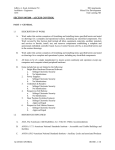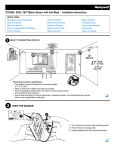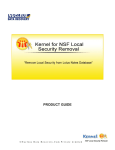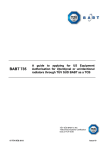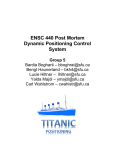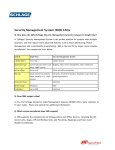Download 1 SECTION PART 1 - GENERAL 016000 – ACCESS CONTROL 1.1
Transcript
SECTION 016000 – ACCESS CONTROL PART 1 - GENERAL 1.1 DESCRIPTION OF WORK A. Work under this section comprises of furnishing and installing items specified herein and noted on drawings for a complete and operational system, including any electrified components. The Work covered by this Section shall include all labor, equipment, materials, ancillary materials and services to furnish, install, test, and turnover components establishing a complete and operational embedded controller based Access Control System (ACS), as described herein and in the contract drawings. B. Work under this section comprises of furnishing and installing items specified herein and noted on drawings for a complete and operational system, including any electrified components. C. All items to be of a single manufacturer to insure system continuity and operation except any computers and computer related peripheral hardware. D. Items include but are not limited to the following: 1.2 1. Bright Blue Hardware/Firmware/Software 2. PIB-300-2D (1 per every 2 locks or trims) 3. Cameras: Fix with PTZ for warehouse 4. Graphical User Interface for PTZ cameras 5. SEVMS-32-BB DVR 6. Power Supplies 7. Credentials & Readers 8. Request-to-Exit Buttons 9. Door Position Switches/Contacts 10. Request-to-exit Motion Sensors RELATED WORK A. Drawings and general provisions of the Contract, including General and Supplementary Conditions and Division 01 Specification Sections, apply to this Section. 087100 - 1 1.3 REFERENCES A. DA, The Americans with Disabilities Act - Title III - Public Accommodations B. ANSI-A 117.1-American National Standards Institute - Accessible and Usable Buildings and facilities. C. ANSI-A156.5-American National Standards Institute - Auxiliary Locks and associated Products D. UFAS - Uniform Federal Accessibility Standards E. UL - Underwriter's Laboratories F. WHI - Warnock Hersey International, Division of Intertech Testing Services G. State and Local Codes including Authority Having Jurisdiction H. FCC: All assemblies shall be in compliance with FCC emission standards 1. 2. Microprocessor based controller: Part 15, Subpart F, Class A. Proximity Card Reading Sensors: Part 15, Subpart F (field disturbance sensors). I. 2000 International Fire Code J. NFPA 70 (1999) National Electric Code International Organization for Standardization (ISO) K. NEMA: Electrical equipment shall comply with applicable portions of NEMA. L. All power supplies shall be in compliance with Underwriters Laboratories standard for UL294, UL603, CSA, CUL and CE standards for power supplies M. The system shall comply with Underwriter Laboratories standards UL294, CSA, CUL and CE for Access Control Systems. 1.4 ABBREVIATIONS AND ACRONYMS A. ACS: Access control system B. EACS: Embedded access control system C. LAN: Local area network D. LED: Light-emitting diode E. TCP/IP: Transport control protocol/Internet protocol incorporated into Microsoft Windows. F. UPS: Uninterruptible power supply 087100 - 2 1.5 DEFINITIONS A. ABA Track: Magnetic stripe that is encoded on track 2, at 75-bpi density in binary-coded decimal format B. Credential: Data assigned to an entity and used to identify that entity. C. Toggle: Double swiping a credential to change the state of a door. D. Pass-Through: The ability assigned to a person’s credential that allows them to access a door even if in lockdown state. E. Lockdown: The ability assigned to a credential that allows the person using this credential to place a door into lockdown state. F. RS-485: A TIA/EIA standard for multipoint communications. G. Wiegand: Patented magnetic principle that uses specially treated wires embedded in the credential card. H. Workstation: A PC with internet access that is connected to the network and can access the controller 1.6 SUBMITTALS A. System Schedules 1. Submit copies of schedule in accordance with Division 1, General Requirements. Supply the schedules within two (2) weeks from date purchase order is received by the system supplier. B. Submit manufacturers' cut/catalog sheets on all system items and any required special mounting instructions with the system schedule. C. Certification of Compliance: 1.7 1. Submit all information necessary to indicate compliance to any or all of these specifications as required. 2. Submit a statement from the manufacturer that system being supplied complies with the operational descriptions exactly as specified. 3. Submit any samples necessary as required by the Architect. QUALITY ASSURANCE A. System supplier to be certified by the equipment manufacturer as capable of installing and supporting and servicing the products to be furnished. Certification shall be submitted on the equipment manufacturer’s letterhead. B. Pre-Installation Conference: Prior to installation arrange conference between supplier, and related trades to review materials, procedures, and coordinating related work. 087100 - 3 C. 1.8 Access Control System 1. The Access Control System shall be furnished and installed by an Authorized Center trained by the manufacturer of the access control system supplied. 2. The Supplier’s Authorized Center office will be a fully staffed local office, within fifty (50) miles of the Owner’s site. The Authorized Center will be staffed by factory trained technicians and must be adequately equipped to provide emergency service within (4) hours on a twenty four (24) hour, 365 days per year basis, whether or not the Owner purchases a maintenance contract with the Authorized Center. 3. The Authorized Center will provide pricing for both 1 year and 5 year service and extended warranty. 4. The Authorized Center will provide all cable installation, identification and termination in accordance with the manufacturer’s technical installation guidance, in addition to all applicable code requirements. 5. The Authorized Center will provide the owner with a four (4) hour manufacturer’s certified administrator training course available for two (2) end-user system administrators. The sessions may be scheduled at any time from the award of the contract. Each system administrator will be provided with complete operating instructions. System training will be supplemented with tutorials that provide the administrator with a basic overview of system navigation, programming and operation. Certification will be provided to system administrators upon successful completion of the training. DELIVERY, HANDLING AND PACKAGING A. Clearly label all packaging as to its contents, in accordance with the system schedule. B. Pack each item complete with all necessary parts and fasteners. C. Properly wrap and cushion each item to prevent scratches and dents during delivery and storage. 1.9 SEQUENCING AND SCHEDULING A. 1.10 Any part of the system, required by the frame or door manufacturers or other suppliers, that is needed in order to produce doors or frames is to be sent to those suppliers in a timely manner, so as not to interrupt job progress WARRANTY A. Manufacturer to supply public website to assist installer and end user at any time with technical assistance and methods to maximize system. B. Warranty is for one year (1) and during system warranty period, system updates via modem or mailings are to be made available to owner. C. During warranty period, the Authorized Center will provide twelve-hour (12) hour toll-free technical support. 087100 - 4 PART 2 - PRODUCTS 2.1 MANUFACTURERS A. 2.2 All items to be of a single manufacturer to insure system continuity and operation except any computers and computer related peripheral hardware. PRECEDENCE A. If any statement in this or any other specification is in conflict with any provision of the General Terms and Conditions to the Contract, the provision stated in the General Terms and conditions shall take precedence. Any questions, which require additional interpretation and guidance, shall be immediately brought to the CUSTOMER’S attention. Architectural drawings shall have precedence over other drawings in regard to dimensions and location. B. Specification 1. Supports up to 32 devices and 5,000 cardholders from controller; supports smart card, proximity and magnetic stripe technologies 2. Database: 4GB flash drive 3. NEMA 1 rated enclosure 4. Recommended cable: 18 AWG/4 COND, stranded, shielded, twisted (up to 500') 5. Linux operating system 6. 32-bit, 200 MHz NET+ARM microprocessor 7. SSL encryption (OPTION) 8. Web-browsers supported: Internet Explorer 7.0, FireFox 9. 10/100 Base-T Ethernet 10. Supports DHCP or Static IP addressing 11. 64Mb flash memory and 64Mb SRAM 12. Tamper switch 13. Supports smart card, magnetic stripe and proximity technologies 14. Flashable firmware 15. Power requirements: 12-24 VDC @ 1A 16. Operating temperature: 0°C to 49°C; 32°F to 120°F 17. Board dimensions: 11.5” H x 11.5”W 18. Enclosure dimensions: 14” H x 14” W x 3.5" D 19. Battery Backup 087100 - 5 2.3 SYSTEM ARCHITECTURE A. System Description: 1. Primary function is to regulate acesss through specific portals to Secured areas and to monitor cameras. 2. Shall utilize card technology as its primary access device. 3. Surge Protection a. Components must be protected from voltage surges originating externally to equipment housing and entering through power, communication, signal, control, or sensing leads. Must also include surge protection for external wiring of each conductor-entry connection to components. B. Power: Any special power treatment required, such as filtering or spike elimination that may be required for proper operation and protection of the ACS, shall be provided with the system. C. Backup Power: ACS equipment shall be supplied from a UPS system, which shall be tied to emergency building power circuits. The UPS shall power the equipment including, but not limited to, the Embedded Controller, electronic locks and lock power supplies for a minimum of 4 hours. The UPS shall provide a minimum of 600VA. D. General Software Description: E. 1. The software shall include applications to accommodate all devices in the construction documents. 2. The software shall be accessible from any PC on the same network as system supplied that has a web browser. General Hardware Description: 1. The Hardware shall be expandable to meet all criteria of this document. F. The PC/workstation computer shall be used to program all access control functions, generate reports, display selected transactions, valid and invalid entry activity, and all internal system status such as communication loss/restore, power loss, etc. G. The system programming should be user friendly and capable of being accomplished by personnel with minimal computer experience. The software shall be of a consistent user interface that is compatible with current software techniques employed by Microsoft and other software developers, namely drop down menus, dialogue boxes, check boxes, etc. H. The System shall provide a means for scheduled automatic backups of any or all database system files. I. The single user system shall have the capability to communicate with the controller via LAN/WAN connections utilizing industry standard TCP/IP communication protocol. 2.4 SYSTEM CAPABILITIES A. All hardware shall be provided with enclosures with hinged doors and locks. 087100 - 6 B. C. The Controller: 1. The controller shall be an intelligent device which shall be able to process all transactions in the system. 2. The controller shall be able to support up to 32 doors and 5,000 cardholders and support smart card, proximity and magnetic stripe technologies. 3. Communication between the controller and the Reader Interface shall be via RS-485 protocol. 4. The controller shall have flashable firmware upgrades. 5. The controller shall have 4GB (or more) of detachable memory to store the database and software. 6. The controller shall incorporate built-in data backup in the form of a lithium battery or ‘Super Cap’ to last 4 hours. 7. The controller shall incorporate a built-in, real time clock for providing scheduled event programming. Clock shall be initially set via the web interface. Reader Interface: 1. Each reader in the system shall have a dedicated Reader Interface. 2. The Reader Interface shall support multiple reader technologies including, but not limited to: a. 3. D. Proximity AD Lock technology shall be supported using a panel interface board (PIB) with direct connection to bright blue controller board via RS-485. Hardware Specifications 1. 2. Embedded Controllers a. Power input – 24VDC@1A b. Power consumption – 170mA (excluding peripheral devices) c. Ambient temperature - 0° to 49° C or 32° to 120° F d. Humidity - 10% to 85% (non-condensing) Reader Interfaces a. Power Input - 12-24 VDC@1A b. Power Consumption – 350mA c. Ambient temperature - 0° to 49° C or 32° to 120° F d. Humidity – 10% to 85% e. (4) unsupervised contact inputs f. (2) Form C single pole/double throw 2-amp mechanically latching relays g. RS-485 communications, two wire cable up to 4,000 feet from the controller h. Multi-color LED for Go and No Go indications 087100 - 7 2.5 DATABASE DESIGN AND MANAGEMENT A. B. Overview 1. System software shall come fully contained on the controller 2. System software shall be accessible from any computer with network access and a web browser. No dedicated PC shall be required. 3. Requires no special software installation nor any additional software. 4. Pre-configured and network ready. 5. Any computer running an Internet Explorer 7 or Firefox web browser must be able to be used to access, monitor and manage the end user system. 6. System must be web based and be able to be accessed like any standard web page on the Internet via a LAN. 7. Ability to run standard reports and to be able to export reporst as .csv files which can be opened in MS Excel and other spreadsheet programs. System Security: The system shall be secure both in its operation and administration. 1. 2. C. Login Requirements: a. Logging into the system shall be restricted using User ID and password. b. Only one operator at a time shall be able to log into the system. c. The operator shall be logged off from the system after an idle period of 5 minutes, requiring that their password be re-entered. Operators will have one of three security levels with the following privileges attached: a. Administrator – Shall allow full access to the system with read/write capabilities. b. Manager – Shall allow partial access to the system with read/write capabilities. c. Operator – Shall allow limited access to the system with read only capabilities. System Management: Software shall allow the user to simultaneously monitor and maintain a secure working environment. 1. System Software shall contain the definition of any door or door related hardware that is connected to the system. There shall be a provision to label each device with at least an alphanumeric description to easily identify the door. 2. Activity Monitor: Software shall allow the user to view Personnel Transactions and System and Device Transactions on a self refreshing screen. The refresh time will be adjustable from 15 seconds to 15 minutes. 3. System State: The software shall provide the ability, via manual override, to place any or all doors into predefined states (i.e. unlocked, lockdown, etc) without having to change individual cardholder access privileges. 4. Calendar Events: The system shall allow the user to define the Calendar Events (holidays, etc.) according to specific needs. 5. Time Zones: Time zone definitions shall include two intervals, each with start and end times, days of the week, occurrence in the month, and Calendar Events. 087100 - 8 D. 6. Door Status: The software shall allow the user to view a single door’s state at any time. The status shall be displayed in a dashboard window when received. 7. Site Codes: a. The software shall be able to assign up to 6 numbers ranging from 1 to 1,000,000. b. Any lost communication shall not interfere with access being granted at readers as site codes are downloaded and retained in the reader memory. c. If the site code on a credential does not match that on the reader board, access will be denied. Personnel Management: Software shall provide a simple interface to add, delete or modify personnel information. 1. Personnel information shall include the following fields: a. First, last and middle name. b. Activation and expiration dates. c. Up to 6 user defined fields of additional information. 2. The personnel record shall contain the unique number that is encoded on their assigned credential. 3. Credential Technology Supported: a. 4. E. F. Proximity The following fields shall be available for use at the administrator’s discretion: a. Stamped ID – The number that is “heat stamped” on the card, different from the encoded ID. b. Issue Code – This number can be incremented by the operator if the magnetic stripe badge is re-issued because it is either damaged or lost. Door Setup: Software shall allow up to 32 doors to be programmed. A simple interface shall be provided to add, delete or modify doors. 1. The software shall provide predefined door types to choose from. 2. The software shall allow the assignment of time zones to doors for use as an unlock schedule. 3. The software shall allow the assignment of an automatic cancel time for toggle commands to each door. 4. The software will allow global settings for doors: a. Credential Technology – Choose what type of credential (proximity, smart card or magnetic stripe) will be used for all doors. b. Site Codes – Choose which site codes to use (if any) for all doors. c. Anti-passback – Define the anti-passback reset time (if any) for all doors. Access Privileges: Software shall allow for assignment of access rights to credential holders. 1. Three levels of access rights authorization 087100 - 9 2. G. 2. I. Administrator b. Manager c. Operator These rights shall cover access ability as well as Toggle, Pass-Through, Lockdown and “First Person In” abilities a. Access Privilege Assignment: Software shall allow access to be assigned on a by person or a by group basis. b. Access Privilege Expiration: Software shall include the ability to force an expiration of access privileges to any or all doors in the system. Manual Overrides: The software shall provide an ability to manually change a device’s normal function, possibly to allow temporary access to a door or to lockdown all doors in an emergency situation. 1. H. a. Manual Overrides shall be predefined in the system. a. Unlock – shall manually lock a door or doors so that only credentials designated as “pass-through” will be able to open them. b. Lockdown - shall manually lock a door or doors so that only credentials designated as “pass-through” will be able to open them. c. Suspend Unlock Schedule – shall override the unlock schedule of a door. d. Resume Normal Operation – shall return a door or doors to its normal state. Some manual override functions shall be able to be activated by a credential: a. Unlock – shall be possible with a toggle enabled credential. b. Lockdown – shall be possible with a lockdown credential. Automatic Overrides: The software shall provide a way to override certain tasks automatically on a regular basis (e.g. unlocking the main lobby door during normal business hours). 1. The user shall be able to define the time zones according to the customer’s needs. 2. First person in rule – The system shall provide a secure way to unlocks an automatic scheduled door. A valid credential access shall be required to trigger the doors scheduled to unlock during a scheduled period. Report Generation: Software shall allow reports to be generated based on the following criteria: 1. Activity: a. All access attempts valid/invalid b. All access attempts valid c. All access attempts invalid d. System user activity e. System events f. Contacts g. Relay 087100 - 10 2. Personnel: a. 3. 4. Access: a. Access permission by person b. Access permission by door Devices: a. 5. J. 2.6 Personal Information All devices by door selection Configuration: a. Timezones b. Calendar events Persons with Disability: The software shall allow for special access accommodation to doors for special access needs personnel. 1. When new personnel are added to the system, the operator shall have an option to select a specific field for Special Access Privileges. 2. When new doors are added to the system, the operator shall have the option to set the Special Access Timers to allow for a longer duration of unlock when personnel with special access privileges present their credential. SCALABILITY A. 2.7 The system is to be designed with upward growth and expansion in mind. All hardware and software components, offered by the manufacturer, shall be easily integrated into the wired and wireless lock system up to 32 locks and 5,000 cardholders of the same manufacturer of the controller and access control system. The system design shall be consistent within a given system and across that system product family in the interest of minimizing the costs of migration and minimizing, if not totally eliminating the need for operator re-training. SYSTEM INTEGRATION A. The system shall be complete and fully integrated with wired and wireless technology with direct connection to the wired and wireless locks of same manufacturer of controller and access control system up to 32 locks and 5,000 cardholders. PART 3 - EXECUTION 3.1 INSTALLATION OF SYSTEM A. Owner to provide designated area with sufficient desk space and electrical outlets required for system computer and computer components. 087100 - 11 B. Installation manual must be supplied which provides guidelines for installing and configuring the controller and the hardware that interfaces with it. This guide is intended to be read by installation technicians and service personnel only. It is not intended for end users of the system. 1. It shall provide step-by-step instructions for: a. Before installation requirements b. Electrical wiring consider c. Before powering system information d. Overview highlights e. Dimensions f. Power supply requirements g. Installation manual configuration guidelines C. Installation and Configuration Steps Manufacturer certified technician to assist in and verify installation of computer, peripheral computer hardware, and system software, installation of locks and card readers, programming and operation of locks and card readers, and to train designated personnel in operation of system. D. Web Browser requirements: 1. Internet Explorer a. 2. Firefox 2 a. E. IE 7 will run on Windows XP Service Pack (SP2), Windows XP Professional x64 Edition, and Windows 2003 Service Pack (SP1). Any machine with the recommended amount of memory for Windows (for example, 128 MB for windows XP and 256 MB for Windows XP Professional x64) will meet the memory requirements for Internet Explorer 7. Firefox 2 will run on Windows 98, Windows 98 SE, Windows ME, Windows NT 4.0, Windows 2000, Windows XP (recommended), and Windows Vista. Any computer running with Pentium 500MHz or greater and 128 (MB) RAM will meet memory requirements for Firefox 2. Note: systems uses port 80 to communicate; as a result this port cannot be blocked by any firewall software. User Manual: 1. User manual must be supplied which provides guidelines for using and the system, controller and the hardware that interfaces with it. It is intended for end users of the system. System Owner’s Manual. a. This document is designed as a detailed user manual for the system. b. It shall provide step-by-step instructions for: 1) Setting up personnel, time zones, doors and holidays 2) Assigning access permissions to personnel 3) Monitoring system activity 4) Running standard reports 087100 - 12 5) Setting up login permissions 6) Troubleshooting END OF SECTION 087100 - 13













